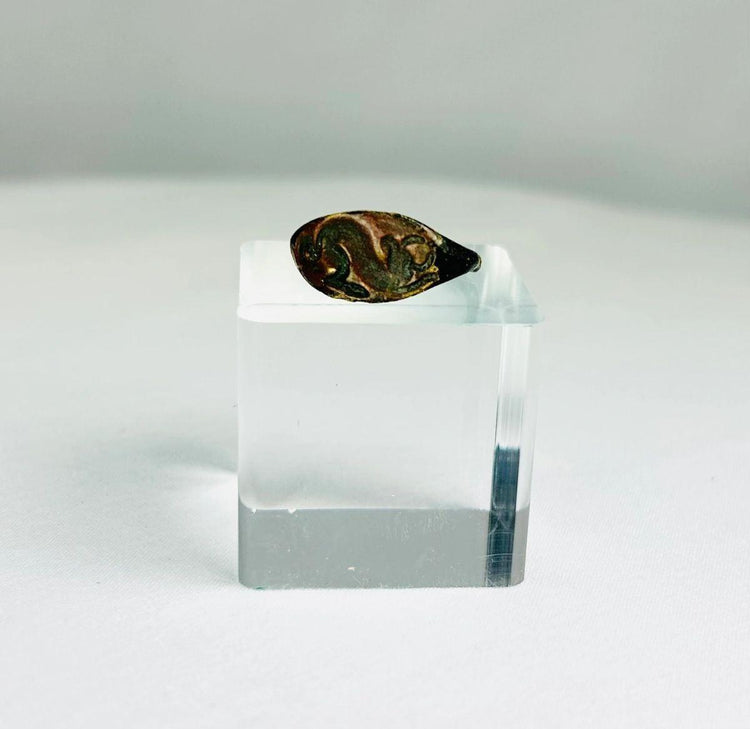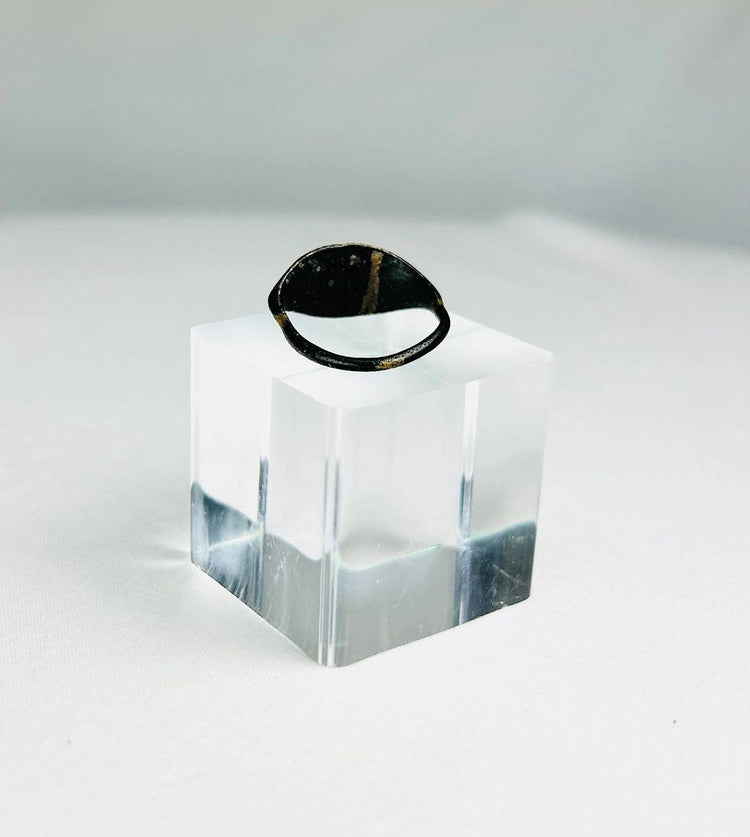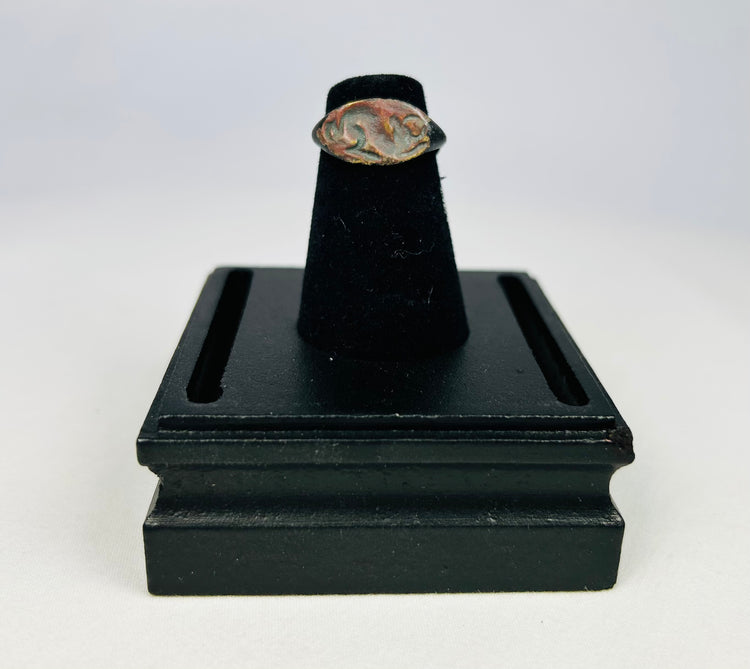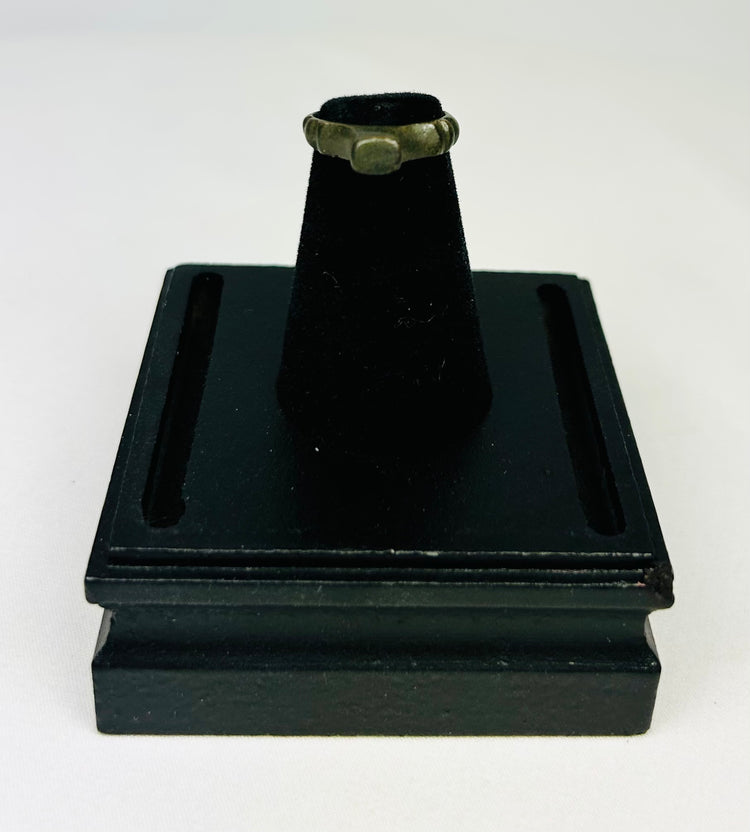Bague en bronze antique avec animal cornu gravé | Ier au IVe siècle de notre ère
Description
Plus
Moins
Contexte historique et origine
Région : Méditerranée ou Proche-Orient
Matériau : Bronze
Période : Ier-IVe siècle de notre ère
Description
Cette bague ancienne en bronze présente un chaton ovale gravé de l'image d'un animal cornu, probablement un taureau, symbole immuable de force, de puissance et de fertilité dans l'Antiquité. Vénéré dans les cultures méditerranéennes et moyen-orientales, le taureau était souvent associé à la prospérité agricole, à l'autorité divine et à la vitalité masculine. La gravure finement incisée reflète à la fois le talent artistique et la signification symbolique des joailliers anciens.
Caractéristiques
- Lunette ovale gravée d'un taureau cornu, symbolisant la force et la fertilité
- Gravure finement détaillée soulignant la puissance et la présence de l'animal
- Patine verte naturelle développée au fil des siècles, renforçant l'authenticité
- Porté à la fois comme ornement et comme expression symbolique de statut et de croyance
Importance culturelle
Dans les sociétés méditerranéennes et moyen-orientales antiques, les taureaux étaient au cœur des mythes, des rituels et de l'iconographie royale. Associé aux dieux, aux rois et à la fertilité, le symbole du taureau incarnait la vitalité et l'autorité divine. Cette bague servait peut-être non seulement de bijou, mais aussi d'emblème protecteur ou cérémoniel, associant celui qui la portait à la force et à la puissance éternelle du taureau.
Condition
Bon état d'usage, avec des traces d'usure et d'abrasion de surface liées à son âge. La patine confère à la pièce un caractère archéologique, soulignant sa longue histoire d'utilisation et de conservation.
Dimensions (approximatives)
Taille de la bague : 6 US
Âge
Ier-IVe siècle de notre ère
Description
Contexte historique et origine
Région : Méditerranée ou Proche-Orient
Matériau : Bronze
Période : Ier-IVe siècle de notre ère
Description
Cette bague ancienne en bronze présente un chaton ovale gravé de l'image d'un animal cornu, probablement un taureau, symbole immuable de force, de puissance et de fertilité dans l'Antiquité. Vénéré dans les cultures méditerranéennes et moyen-orientales, le taureau était souvent associé à la prospérité agricole, à l'autorité divine et à la vitalité masculine. La gravure finement incisée reflète à la fois le talent artistique et la signification symbolique des joailliers anciens.
Caractéristiques
- Lunette ovale gravée d'un taureau cornu, symbolisant la force et la fertilité
- Gravure finement détaillée soulignant la puissance et la présence de l'animal
- Patine verte naturelle développée au fil des siècles, renforçant l'authenticité
- Porté à la fois comme ornement et comme expression symbolique de statut et de croyance
Importance culturelle
Dans les sociétés méditerranéennes et moyen-orientales antiques, les taureaux étaient au cœur des mythes, des rituels et de l'iconographie royale. Associé aux dieux, aux rois et à la fertilité, le symbole du taureau incarnait la vitalité et l'autorité divine. Cette bague servait peut-être non seulement de bijou, mais aussi d'emblème protecteur ou cérémoniel, associant celui qui la portait à la force et à la puissance éternelle du taureau.
Condition
Bon état d'usage, avec des traces d'usure et d'abrasion de surface liées à son âge. La patine confère à la pièce un caractère archéologique, soulignant sa longue histoire d'utilisation et de conservation.
Dimensions (approximatives)
Taille de la bague : 6 US
Âge
Ier-IVe siècle de notre ère
Vous aimerez peut-être aussi





























